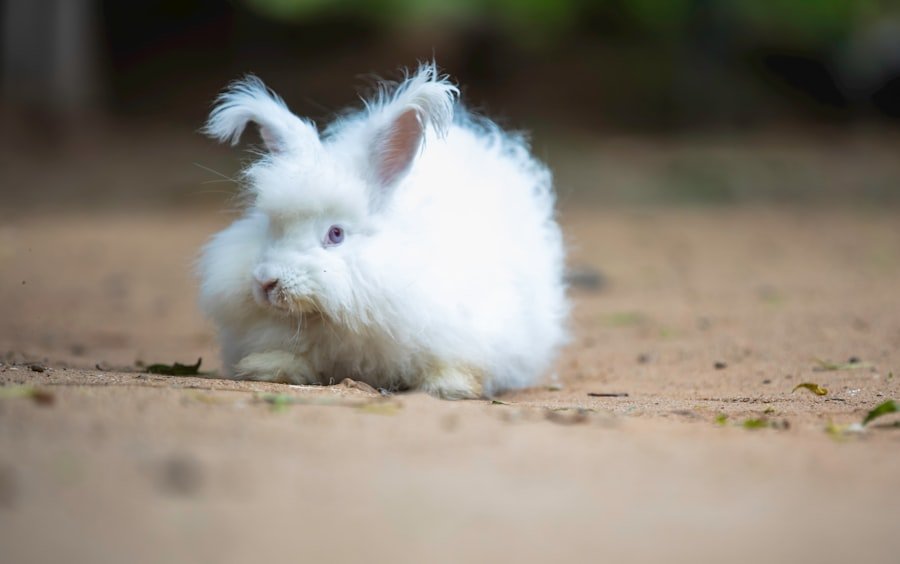Angora rabbits are a unique and fascinating breed known for their luxurious wool. These rabbits have captivated the hearts of many with their adorable appearance and soft, fluffy coats. However, there is much more to angora rabbits than meets the eye. From their rich history to their care requirements and the ethical considerations surrounding their farming, the topic of angora rabbits is both perplexing and bursty.
Key Takeaways
- Angora rabbits are known for their soft and fluffy fur, which makes them popular for wool production.
- These rabbits have a long history, originating in Turkey and being bred for their wool for centuries.
- There are four main types of Angora rabbits: English, French, Giant, and Satin.
- Proper care and maintenance of Angora rabbits includes regular grooming, a healthy diet, and a clean living environment.
- Raising Angora rabbits can provide benefits such as a sustainable source of wool and a rewarding hobby, but it’s important to consider the ethical implications of farming these animals.
The History and Origin of Angora Rabbits
The origins of angora rabbits can be traced back to ancient times in what is now modern-day Turkey. These rabbits were highly prized for their wool, which was used to create luxurious textiles. It wasn’t until the 18th century that angora rabbits were introduced to Europe, thanks to the efforts of French and English breeders.
France played a significant role in the development of angora rabbit breeding. In the mid-18th century, French sailors brought back angora rabbits from Ankara, Turkey, which is where the breed gets its name. These rabbits were then bred with local European breeds to create what is now known as the English angora rabbit.
England also played a crucial role in the development of angora rabbit breeding. In the early 19th century, English breeders began importing angora rabbits from France and further refining the breed. They focused on improving the quality of the wool and creating a more standardized appearance for show purposes.
Understanding the Different Types of Angora Rabbits
There are three main types of angora rabbits: English, French, and Giant. Each type has its own unique characteristics in terms of size, wool quality, and temperament.
English angora rabbits are known for their small size and dense, silky wool. They have a gentle and docile temperament, making them suitable as pets or show animals. French angora rabbits, on the other hand, are larger in size and have a wool that is slightly coarser than that of the English angora. They are known for their playful and curious nature.
Giant angora rabbits are the largest of the three types and have a wool that is similar in quality to that of the French angora. They are known for their calm and friendly temperament, making them popular as pets. However, due to their large size, they require more space and may not be suitable for all households.
The Care and Maintenance of Angora Rabbits
| Topic | Description |
|---|---|
| Grooming | Angora rabbits require daily grooming to prevent matting and hairballs. |
| Diet | Angora rabbits need a diet high in fiber, such as hay and fresh vegetables. |
| Housing | Angora rabbits should be kept in a clean, dry, and well-ventilated area with plenty of space to move around. |
| Exercise | Angora rabbits need regular exercise to prevent obesity and maintain good health. |
| Health | Angora rabbits are prone to certain health issues, such as wool block and dental problems, and should receive regular check-ups from a veterinarian. |
Angora rabbits require specific care and maintenance to ensure their health and well-being. One of the most important aspects of caring for angora rabbits is regular grooming. Their wool is prone to matting and can become tangled if not properly maintained. Regular brushing is necessary to prevent matting and to keep the wool clean and free from debris.
In addition to grooming, angora rabbits require a balanced diet that includes a variety of fresh vegetables, hay, and pellets. They also need access to clean water at all times. Housing for angora rabbits should provide enough space for them to move around comfortably, with separate areas for eating, sleeping, and using the litter box.
Another important aspect of caring for angora rabbits is shearing. The wool of angora rabbits grows continuously and needs to be sheared regularly to prevent it from becoming too long and causing discomfort or health issues. Shearing should be done by a professional or someone with experience to ensure the safety of the rabbit.
The Benefits of Raising Angora Rabbits
Raising angora rabbits can be a rewarding experience with several benefits. One of the main benefits is their wool production. Angora rabbits produce a high-quality wool that is prized for its softness and warmth. This wool can be used to create a variety of products, including clothing, accessories, and home decor items.
In addition to the wool production, angora rabbits can also be a source of income. The demand for angora wool products is high, and there is potential for profit in selling the wool or products made from it. However, it is important to note that raising angora rabbits for profit requires dedication and knowledge of the breed.
Furthermore, angora rabbit farming is considered to be more sustainable compared to other forms of animal agriculture. Angora rabbits have a small ecological footprint and require less space and resources compared to larger livestock animals. They also produce a renewable resource in the form of their wool, which can be harvested without harming the rabbit.
Angora Rabbits as Pets: What You Need to Know

While angora rabbits can make wonderful pets, it is important to understand their temperament and care requirements before bringing one into your home. Angora rabbits are generally docile and friendly, but they can be sensitive and require gentle handling. They may not be suitable for households with young children who may not understand how to handle them properly.
In terms of care requirements, angora rabbits need regular grooming to prevent matting and keep their wool clean. This can be time-consuming and may require assistance from a professional groomer. Additionally, angora rabbits need a balanced diet and a suitable living environment that provides enough space for them to move around comfortably.
It is also important to consider the potential challenges of owning an angora rabbit. Their wool can be high maintenance, and some individuals may have allergies or sensitivities to rabbit fur. Additionally, angora rabbits are prone to certain health issues, such as dental problems and gastrointestinal stasis. It is important to be prepared for these potential challenges and have access to a knowledgeable veterinarian.
The Process of Shearing Angora Rabbits
Shearing is an essential part of caring for angora rabbits and should be done regularly to prevent their wool from becoming too long and causing discomfort or health issues. The process of shearing angora rabbits involves using specialized tools and techniques to remove the wool without harming the rabbit.
The tools used for shearing angora rabbits include sharp scissors or clippers, a grooming table or surface, and a brush or comb to help separate the wool. It is important to use sharp and clean tools to ensure a clean cut and minimize the risk of injury to the rabbit.
The shearing process should be done in a calm and quiet environment to minimize stress for the rabbit. It is important to handle the rabbit gently and avoid pulling or tugging on the wool. The wool should be carefully removed in sections, starting from the back and working towards the front.
It is crucial to practice humane shearing practices and prioritize the well-being of the rabbit throughout the process. Shearing should be done by a professional or someone with experience to ensure that it is done safely and effectively.
The Versatility of Angora Wool: From Clothing to Home Decor
Angora wool is highly versatile and can be used to create a wide range of products. Its softness and warmth make it ideal for clothing items such as sweaters, scarves, hats, and gloves. The natural insulation properties of angora wool make it perfect for keeping warm in cold weather.
In addition to clothing, angora wool can also be used in accessories such as socks, blankets, and shawls. Its soft texture adds a luxurious touch to these items, making them both functional and stylish.
Angora wool is also popular in home decor items such as pillows, throws, and rugs. Its softness and warmth make it perfect for creating cozy and inviting spaces. The natural color variations in angora wool add depth and texture to these items, making them visually appealing.
The Ethics of Angora Rabbit Farming
The ethics of angora rabbit farming have been a topic of debate in recent years. Concerns have been raised about the welfare of the rabbits and the practices used to harvest their wool. It is important for angora rabbit farmers to prioritize the well-being of the rabbits and ensure that they are treated with care and respect.
Responsible farming practices include providing the rabbits with a suitable living environment, access to clean water and a balanced diet, and regular veterinary care. It is also important to handle the rabbits gently and avoid causing them unnecessary stress or discomfort.
Transparency in the industry is also crucial. Consumers should be able to make informed choices about the products they purchase, including knowing where the wool comes from and how it was harvested. Angora rabbit farmers should be open and honest about their practices and be willing to answer any questions or concerns from consumers.
The Future of Angora Rabbits: Sustainability and Conservation Efforts
The future of angora rabbits lies in sustainable and conservation-focused breeding practices. It is important to preserve the genetic diversity of angora rabbits and ensure that they continue to thrive in the larger ecosystem.
Conservation efforts should focus on maintaining healthy populations of angora rabbits in their natural habitats and protecting their habitats from destruction or degradation. This can be done through habitat restoration, conservation education, and collaboration with local communities.
Sustainable breeding practices should prioritize the health and well-being of the rabbits, as well as the quality of their wool. This includes selecting breeding pairs based on their genetic diversity, health history, and wool quality. It also involves promoting responsible farming practices and transparency in the industry.
By taking these steps, we can ensure that angora rabbits continue to be a part of our lives for generations to come while also respecting their natural habitats and promoting their welfare.
Angora rabbits are truly unique creatures with a rich history and fascinating characteristics. From their origins in ancient Turkey to their introduction to Europe and the development of different breeds, angora rabbits have captured the hearts of many.
Caring for angora rabbits requires dedication and knowledge, but the rewards are plentiful. Their wool production and potential for profit make them a valuable asset, while their sustainability and small ecological footprint make them an attractive option for those looking for a more sustainable form of animal agriculture.
Whether as pets or as a source of wool, angora rabbits bring joy and beauty into our lives. It is important to approach their farming and ownership with responsibility and care, prioritizing their welfare and promoting transparency in the industry.
As we look to the future, it is crucial to focus on sustainable breeding practices and conservation efforts to ensure that angora rabbits continue to thrive. By doing so, we can preserve their genetic diversity and protect their natural habitats for generations to come.

